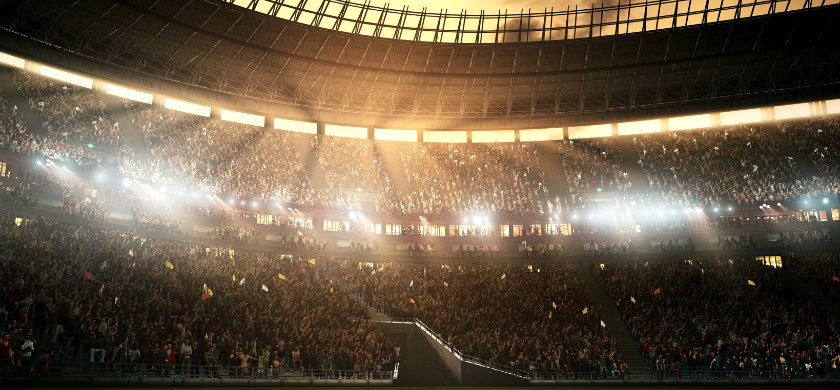The stadium experience is changing, and so are fan expectations. In a study from Oracle, fans consistently ranked technology as a key subject of importance across major sports — ranking higher than both entertainment & traditional amenities. Today, offering exciting technological advancements to visitors is essential for stadiums to remain competitive & relevant.
IoT is an essential tool in upgrading the technology of your stadium. Discover what exactly falls under the term IoT, what type of IoT technology can be used in stadiums, and 5 essential applications to satisfy and impress fans.
- What is the Internet of Things (IoT)?
- What Types of IoT Technology Can Be Used in Sports Stadiums?
- 5 Essential IoT Applications for Smart Stadiums
What is the Internet of Things (IoT)?
The Internet of Things (IoT) refers to the massive, interconnected network of physical devices loaded with sensors, software, and any other technology leveraged to exchange information over the internet.
Obviously, this definition is expansive, encompassing a wide variety of devices and technology. IoT may include routers, modems, cellphones, and even smart homes & cars — all of this technology falls under the diverse umbrella of IoT.

What Types of IoT Technology Can Be Used in Sports Stadiums?
Considering the term’s broad definition, the types of IoT technology that can be used in stadiums is also incredibly expansive. Potential examples include:
- High Bandwidth WiFi Routers to support various stadium network capabilities.
- Mobile Check-In Devices for online, connected guest ticketing.
- Smartphones Connected to Stadium Apps for diverse fan experiences.
- Smart Sensors to streamline overall stadium management and energy consumption.
Because IoT devices can be so diverse and versatile, use of IoT technology in stadiums matters less about what technology is used and more about how that technology is used.
5 Essential IoT Applications for Smart Stadiums
Leveraging intuitive IoT technology into your stadium design can increase ROI, supercharge fan engagement, and increase your property’s bottom line. To turn your venue into a smart stadium, effective, smart applications of IoT devices are essential.
Here are 5 essential ways to leverage IoT technology in your stadium, alongside the technology necessary to implement them.
Increasing Fan Social Media Engagement
Social media engagement serves as a key way to invest fans in the stadium experience, leading to greater fan satisfaction and organic, word-of-mouth marketing. To allow seamless, intuitive access to social media, however, stadiums need to leverage IoT technology.
Fans should be able to access social media from their devices from anywhere in your stadium — from their seats to souvenir shops. In turn, stadiums need to skillfully leverage WiFi router & access point placement to keep fans connected.
Stadiums should also encourage fans to take out mobile devices, both during games and through calls-to-action placed throughout a venue. By consistently reminding fans when & where to post, or even driving them to the social platform directly via QR codes, stadiums ensure a high conversion rate on social media engagement. Check out our blog for further strategies for increasing social media engagement with sports fans in stadiums.
Adaptive, Responsive Stadium Wayfinding
Above everything else, fans come to stadiums to experience an event. From high-octane sports matches to heart-pounding concerts, attendees don’t want to miss a minute of the action. As stadiums grow in complexity and scope, however, fans are at an increasing risk of getting lost within stadiums — leading to potential frustration towards missed moments.
Responsive stadium wayfinding allows fans to navigate your venue stress-free. Stadium wayfinding comes in two distinct forms: mobile wayfinding and digital signage. Whatever the means, intuitive wayfinding can help exceed guest expectations for your events.
Mobile wayfinding uses real-time location tracking via guest devices to help them navigate stadiums. Access to mobile wayfinding requires a guest smart device (smartphones, smartwatches, etc.) & responsive, accurate WiFi access (routers, additional access points).
Digital signage, meanwhile, allows guests to explore stadiums via directions placed in specific touchpoints. Signage can be both interactive — allowing for touch screen navigation of virtual maps — and updated in real-time — showing updates to game scores and current wait-times at stadium concessions. Oftentimes, digital signage displays are in and of themselves IoT devices.
Improving Overall Fan Experience
IoT technology streamlines & optimizes the entirety of the stadium fan experience. Using stadiums fan apps, attendees can control diverse aspects of their visit to a stadium. Smartphones provide access to stadium concessions, digitized tickets, and even more stadium services — acting as a centralized fan experience hub.
While smart devices serve as a hub for fans, stadiums need to install additional IoT devices to allow staff to meet fan needs. Concession stands need internet-enabled PoS software and infrastructure to receive and communicate online orders. Ticketing services also need responsive connections to steadily scan and admit attendees with online tickets.
Smarter, Efficient Facilities Management
With millions of fans and dozens of yearly events, stadiums generate massive amounts of waste and consume high volumes of energy. Waste Management (WM) estimates that the four major American professional sports leagues (NFL, MLB, NBA, NHL) generate approximately 35,000 metric tons of carbon dioxide (CO2) annually — from fans’ waste activities alone. Not only does this waste hurt the environment, but overzealous energy consumption also hurts a stadium’s bottom line.
IoT-enabled facilities management can help stadiums combat wasteful practices. Online inventory management software can connect to concession stands & souvenir shops to ensure efficient utilization of supplies. Additionally, sensor-activated restrooms can turn off lights and track water use to minimize consumption.
Implementing Reliable, Expansive Stadium WiFi
Ultimately, all IoT solutions tie back to one central need — responsive, reliable stadium WiFi. Without consistent internet access, IoT devices are virtually useless; leveraging an experienced team to install a high-bandwidth WiFi network in your stadium is key to leveraging all IoT devices and capabilities.

Support Smart Stadium IoT with Internet Connectivity From Hospitality Network
Hospitality Network is a leading provider of stadium internet solutions across the country. Our smart stadium solutions support the cutting-edge of new stadium design — including for diverse applications of IoT devices.
Looking to jumpstart IoT connectivity in your stadium? Request a free consultation with our team and begin your smart stadium evolution today.

